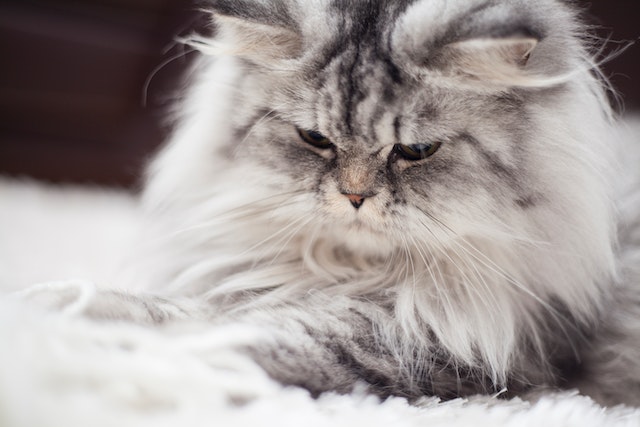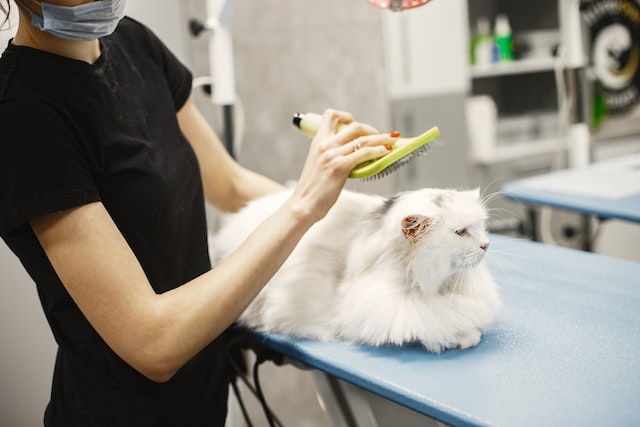Cat hair loss is a disorder that occurs in cats Partial loss appears as a patch that can be cured by home treatment for cat hair loss or total loss of alopecia that needs a veterinarian to see it.
It occurs due to many causes that make cats feel discomfort, biting and scratching their skin which causes loss of hair.
The diagnosis is so important to know the cause and exclude the life-threatening disease and to find a cure.

Cat hair loss can infect different places
1- Back legs; the most common cause of hair loss is fleas.
2- Back near the tail; hair loss due to dysfunction of the sebaceous gland, so the home treatment for cat hair loss with home routines.
3- Ears hair loss characterized by dark-colored ear wax.
4- Above the eyes; hair loss is a natural part of aging.
5- Neck, nose, and bellies; it's a sign of hormonal
imbalance.
Causes of cat hair loss
Alopecia is a partial or complete loss of hair, it may be congenital or acquired that can be cured by home treatment for cat hair loss.
Congenital
Hair follicles not developed normally and start with birth.
Acquired
It related to underlying health conditions that disrepute hair follicles as:
1- Parasites:
Parasites( fleece, ticks, and mites) make cats excessively bite and scratch, resulting in hair loss.
2- Fungal infections:
It’s called ringworm that can infect the hair, claw, and outer layer of the skin.
3- Bacterial infection:
When a cat excessively grooms or scratches herself, it injures the skin and feels discomfort so it starts licking the site of injury which keeps it wet and doesn’t heal, and is the source of bacteria.
4- Psychological factors:
Psychogenic alopecia occurs when the cat pulls out so much hair due to mental or emotional conflict, it’s called self-trauma.
Stressful changes and anxiety about moving to a new place, and afraid of other bets or new person.
5- Poor diet:
Deficiencies of proteins and vitamins result in thinner, brittle, and hair loss.
6- Pregnancy and lactation:
A deficiency of calcium and minerals occurs during pregnancy and lactation leading to temporary loss of hair.
7- Allergies to food or environment:
Cats can suffer from allergies like humans from both food-based allergies, and environmental ones.
Home treatment for cat hair loss that caused by food allergies is to avoid this type of food and change it.
8- Trauma or burns:
Cats can get burns on their feet due to walking on hot surfaces such as cooktops or on surfaces treated with chemicals such as bleaches.
9- Metabolic conditions:
Hyperthyroidism increases cortisol; thinning of the hair and loss of it.
10- Cancer and its treatment:
Loss of hair caused by cancer is rare.
11- Excessive grooming:
The way that the cats keep themselves clean but over-grooming leads to hair loss.
Signs and symptoms
- Itching that makes the cat discomfort and starts to bite, scratch, and injure her skin and loss hair; home treatment for cat hair loss is easy to apply to decrease the sense of itching.
- Redness due to inflammation.
- Patches with hair loss.
- Blisters are caused by scratching and biting.
- Skin loss.
- Bad odors.
- Changes in behavior.

How to prevent hair loss for cats
Regular checks for any signs of hair loss and applying home treatment for cat hair loss as soon as possible could prevent the hair loss from growing and advancing.
Regular baths with herbs that kill the bugs and natural ingredients like oatmeal.
Prevent dandruff by using camomile in the bath of a cat.
Diary meals should contain proteins that are easy to digest like salmon, and rich with vitamins E and B.
The cat should be vaccinated to protect them from a disease that causes hair loss.
Reduce stress in a cat environment.
When we need to call the vet:
When hair loss in a cat is more than normal or all over the body, there are dark patches, dry skin, increased thirst, and urination, eating too much/or too little, vomiting or diarrhea, an enlarged abdomen, and changes in the energy level.
There are signs of systemic disease such as cancer or toxins, So it's time to visit the veterinarian.
The veterinarian will do more diagnostic tests( fungal culture, skin biopsy, urinalysis, blood test, allergy test).
Also, x-ray and/or ultrasound to determine the cause of hair loss and find the way to treat cats at the clinic if needed.
Or if it can be treated by simple home treatment for cat hair loss. The treatment may be localized like an ointment or systemic medication that treats the main cause of hair loss.
The treatment time for hair loss depends on the underlying cause, which may arrange from weeks to months.
Most cases of cat hair loss can be treated if we apply the steps of diagnosis and treat the cause by applying home treatment for cat hair loss as early as possible.

Home treatment for cat hair loss
Home treatment for cat hair loss due to parasites by:
Citrus
As for lemon, we make a spray from lemon slices on boiling water all over the night and spray it at the hair of the cat behind the ears, the base of the tail, the head, and the arms.
Apple Cider Vinegar
It treats hair loss in cats by exerting acidic smells that expel parasites.
Garlic
Moreover, effective home treatments for cat hair loss caused by ringworm by making a paste of crushed garlic.
Castor Or Olive Oil
One more effective home treatment for cat hair loss is the use of castor or olive oil without washing to decrease the sense of itching.
Yeast tablets:
Yeast tablets are rich in vitamin B, Zinc, Phosphorus, and Magnesium which support the health and beauty of cat skin.
Conclusion:
So the advice deal with your cat as your baby. Care of them and their food, the environment around here.
If you notice any changes or excessive hair loss you should call the veterinarian.
Home treatment for cat hair loss is easy to apply with some home care routines.
Once the underlying cause is treated, your cat will recover from hair loss.
Read more about:


You must be logged in to post a comment.